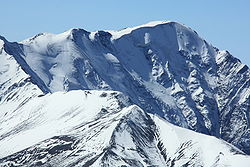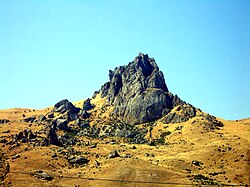
Azerbaijan is a country in the Caucasus region, situated at the juncture of Eastern Europe and West Asia. Three physical features dominate Azerbaijan: the Caspian Sea, whose shoreline forms a natural boundary to the east; the Greater Caucasus mountain range to the north; and the extensive flatlands at the country's center. About the size of Portugal or the US state of Maine, Azerbaijan has a total land area of approximately 86,600 km², less than 1% of the land area of the former Soviet Union. Of the three Transcaucasian states, Azerbaijan has the greatest land area. Special administrative subdivisions are the Nakhchivan Autonomous Republic, which is separated from the rest of Azerbaijan by a strip of Armenian territory, and the Nagorno-Karabakh Autonomous Region, entirely within Azerbaijan. The status of Nagorno-Karabakh is disputed by Armenia, but is internationally recognized as territory of Azerbaijan.

Armenia is a landlocked country in the South Caucasus region of the Caucasus. The country is geographically located in West Asia, within the Armenian plateau. Armenia is bordered on the north and east by Georgia and Azerbaijan and on the south and west by Iran, Azerbaijan's exclave Nakhchivan, and Turkey.

The Caucasus Mountains is a mountain range at the intersection of Asia and Europe. Stretching between the Black Sea and the Caspian Sea, they are surrounded by the Caucasus region and are home to Mount Elbrus, the highest peak in Europe at 5,642 metres (18,510 ft) above sea level.

Gadabay District is one of the 66 districts of Azerbaijan. It is located in the west of the country and belongs to the Gazakh-Tovuz Economic Region. The district borders the districts of Dashkasan, Shamkir, Tovuz, and the Gegharkunik and Tavush provinces of Armenia. The Artsvashen exclave of Armenia is surrounded by the Gadabay District and is de facto controlled by Azerbaijan, administrated as part of Goranboy District. Its capital and largest city is Gadabay. As of 2020, the district had a population of 109,900.

Qabala District is one of the 69 districts of Azerbaijan. It is located in the north of the country in the Shaki-Zagatala Economic Region. The district borders the districts of Oghuz, Shaki, Agdash, Goychay, Ismayilli, Quba, Qusar, and the Russian Republic of Dagestan. Its capital and largest city is Qabala. As of 2020, the district had a population of 107,800.

The Lesser Caucasus or Lesser Caucasus Mountains, also called Caucasus Minor, is the second of the two main ranges of the Caucasus Mountains, of length about 600 km (370 mi). The western portion of the Lesser Caucasus overlaps and converges with east Turkey and northwest Iran. It runs parallel to the Greater Caucasus, at a distance averaging about 100 km (62 mi) south from the Likhi Range (Georgia) and limits east Turkey from the north and north-east. It is connected to the Greater Caucasus by the Likhi Range (Georgia) and separated from it by the Kolkhida Lowland (Georgia) in the west and Kura-Aras Lowland (Azerbaijan) in the east.
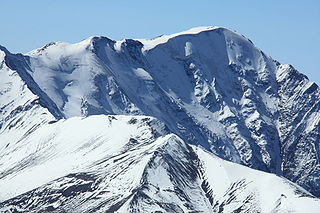
Mount Bazardüzü is a mountain peak in the Greater Caucasus range on the border between Russia (Dagestan) and Azerbaijan. At 4,466 metres (14,652 ft) above sea level, it is the highest peak in both Dagestan and Azerbaijan, and is located in the Qusar region. The southernmost point of Dagestan is located about seven kilometers southwest of the peak. Translated from Azerbaijani, Bazarduzu means “market square”, more precisely as a specific landmark - “turn to the market, bazaar”. In the Middle Ages in the Shahnabad Valley, located east of this peak, annual large multinational fairs were held.

The environment of Azerbaijan, includes a wide diversity of climates, animals, plants, and habitats.

Orography of Azerbaijan refers to the rocky, mountainous and elevated terrains in Azerbaijan. The tectonic structure is typical for the orography of the country. The main morphostructural units are the Greater Caucasus, the Lesser Caucasus, the Gusar plane, the Samur-Devechi lowland, the Kur intermountain trough, the Karabagh volcanic highland, the near and middle Araz Ridges and Talysh Mountains.
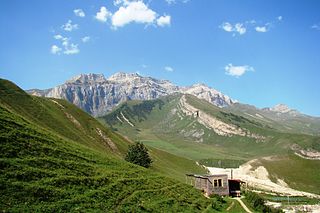
Mount Shahdagh is a mountain peak of the Greater Caucasus range, located in the Qusar District of Azerbaijan, close to the border with Russia. The elevation of the peak is 4,243 metres (13,921 ft) above sea level.
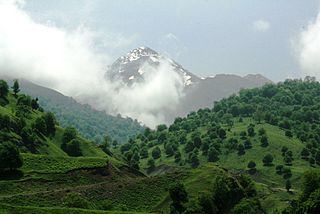
The Murovdağ or Mrav is the highest mountain range in the Lesser Caucasus. The range is about 70 kilometres (43 mi) long, and Gamish Mountain is its highest peak at 3,724 metres (12,218 ft). It is made up mainly of Jurassic, Cretaceous and Paleogene rocks.

Tourism in Azerbaijan has been an important sector of the Azerbaijani economy since the 1990s. According to Azerbaijan's Center for Economic and Social Development, the country is in 39th place among 148 countries in tourism competitiveness indicators. The World Travel and Tourism Council reported that Azerbaijan is among the top ten countries with the greatest increase in visitor exports from 2010 to 2016. The country had the world's fastest-developing travel and tourism economy in 2017. To promote tourism, Azerbaijan sponsored Atlético Madrid jerseys reading "Azerbaijan – Land of Fire". In 2018, a new tourism brand and a slogan "take another look" were introduced.

Buzeyir cave – is an archaeological site and Paleolithic place of human habitation. The cave is located on the left bank of the Zuvandchay River, at the top of Delikli-Dash Mountain, 3 km (1.9 mi) at an altitude of 1,640 m (5,380 ft) above sea level and to the east of Büzeyir village in Lerik Rayon, Azerbaijan.

The geology of Armenia was shaped by geological upheaval pushed up the Earth's crust to form the Armenian Plateau 25 million years ago. This created the complex topography of Armenia.
Republic is a high peak in Gusar District of Azerbaijan. It is part of the Greater Caucasus mountain range, with a summit elevation of 12,270 feet (3,740 m) above sea level. The peak was named Republic and a monument was built on the peak dedicated to 100th anniversary of the Azerbaijan Democratic Republic on 28 May. A road to the mountain peak was opened on 3 May, while the first climb occurred on 28 May, 2018. The project was part of the Azerbaijani President Ilham Aliyev's "Year of the Republic" order.

The Nakhchivan Autonomous Republic is one of the touristic regions of Azerbaijan with its flora and fauna, climate, and ancient cultural monuments. Nakhchivan is known for its historical monuments such as Momuna Khatun, Yusif ibn Kuseyir, Gulustan tombs, and Garabaghlar. There are other touristic places like Babek castle, Kilit cave, Alinja castle, and Gamigaya in Nakhchivan.

Tufandagh is a mountain peak of the Greater Caucasus range, located in the Qusar District of Azerbaijan. With an elevation of 4,191 metres (13,750 ft) above sea level, it third highest mountain in Azerbaijan.
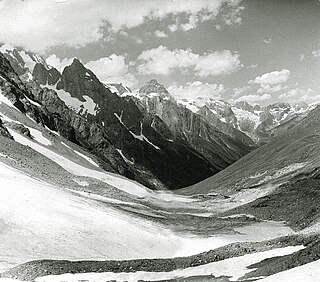
The Main Caucasian Range is a mountain range in the Russian Federation, Georgia and Azerbaijan. It is the dividing range of the Greater Caucasus.
